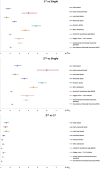Perinatal outcomes in twin pregnancies complicated by maternal morbidity: evidence from the WHO Multicountry Survey on Maternal and Newborn Health
- PMID: 30453908
- PMCID: PMC6245698
- DOI: 10.1186/s12884-018-2082-9
Perinatal outcomes in twin pregnancies complicated by maternal morbidity: evidence from the WHO Multicountry Survey on Maternal and Newborn Health
Abstract
Background: Twin pregnancy was associated with significantly higher rates of adverse neonatal and perinatal outcomes, especially for the second twin. In addition, the maternal complications (potentially life-threatening conditions-PLTC, maternal near miss-MNM, and maternal mortality-MM) are directly related to twin pregnancy and independently associated with adverse perinatal outcome. The objective of the preset study is to evaluate perinatal outcomes associated with twin pregnancies, stratified by severe maternal morbidity and order of birth.
Methods: Secondary analysis of the WHO Multicountry Survey on Maternal and Newborn Health (WHOMCS), a cross-sectional study implemented in 29 countries. Data from 8568 twin deliveries were compared with 308,127 singleton deliveries. The occurrence of adverse perinatal outcomes and maternal complications were assessed. Factors independently associated with adverse perinatal outcomes were reported with adjusted PR (Prevalence Ratio) and 95%CI.
Results: The occurrence of severe maternal morbidity and maternal death was significantly higher among twin compared to singleton pregnancies in all regions. Twin deliveries were associated with higher rates of preterm delivery (37.1%), Apgar scores less than 7 at 5th minute (7.8 and 10.1% respectively for first and second twins), low birth weight (53.2% for the first and 61.1% for the second twin), stillbirth (3.6% for the first and 5.7% for the second twin), early neonatal death (3.5% for the first and 5.2% for the second twin), admission to NICU (23.6% for the first and 29.3% for the second twin) and any adverse perinatal outcomes (67% for the first twin and 72.3% for the second). Outcomes were consistently worse for the second twin across all outcomes. Poisson multiple regression analysis identified several factors independently associated with an adverse perinatal outcome, including both maternal complications and twin pregnancy.
Conclusion: Twin pregnancy is significantly associated with severe maternal morbidity and with worse perinatal outcomes, especially for the second twin.
Keywords: Maternal morbidity; Perinatal outcome; Twin pregnancy.
Conflict of interest statement
Ethics approval and consent to participate
The study protocol was approved by the WHO Ethical Review Committee and by relevant Institutional Review Boards in participating countries and institutions. The WHOMCS was a study of anonymized data, extracted from medical records (with no contact with women) and therefore individual consent was not required.
Consent for publication
Not applicable.
Competing interests
Prof. Fernanda G Surita is an Associate Editor of BMC Pregnancy and Childbirth. The authors declare that they have no competing interests.
Publisher’s Note
Springer Nature remains neutral with regard to jurisdictional claims in published maps and institutional affiliations.
Figures



References
-
- World Health Organization. Neonatal and perinatal mortality: country, regional and global estimates. 2006. http://apps.who.int/iris/bitstream/10665/43444/1/9241563206_eng.pdf . Access on 2nd Apr. 2016.
-
- United Nations. The Millennium Development Goals Report 2015. http://www.un.org/millenniumgoals/2015_MDG_Report/pdf/MDG%202015%20rev%2... . Access on 2nd Apr. 2016.
-
- United Nations. Sustain Dev Goals: 17 goals to transform our world. 2015. http://www.un.org/sustainabledevelopment/health. Access on 2nd Apr. 2016.
-
- Rizwan N, Abbasi RM, Mughal R. Maternal morbidity and perinatal outcome with twin pregnancy. J Ayub Med Coll Abbottabad. 2010;22(2):105–107. - PubMed
MeSH terms
Grants and funding
LinkOut - more resources
Full Text Sources
Medical
Research Materials

